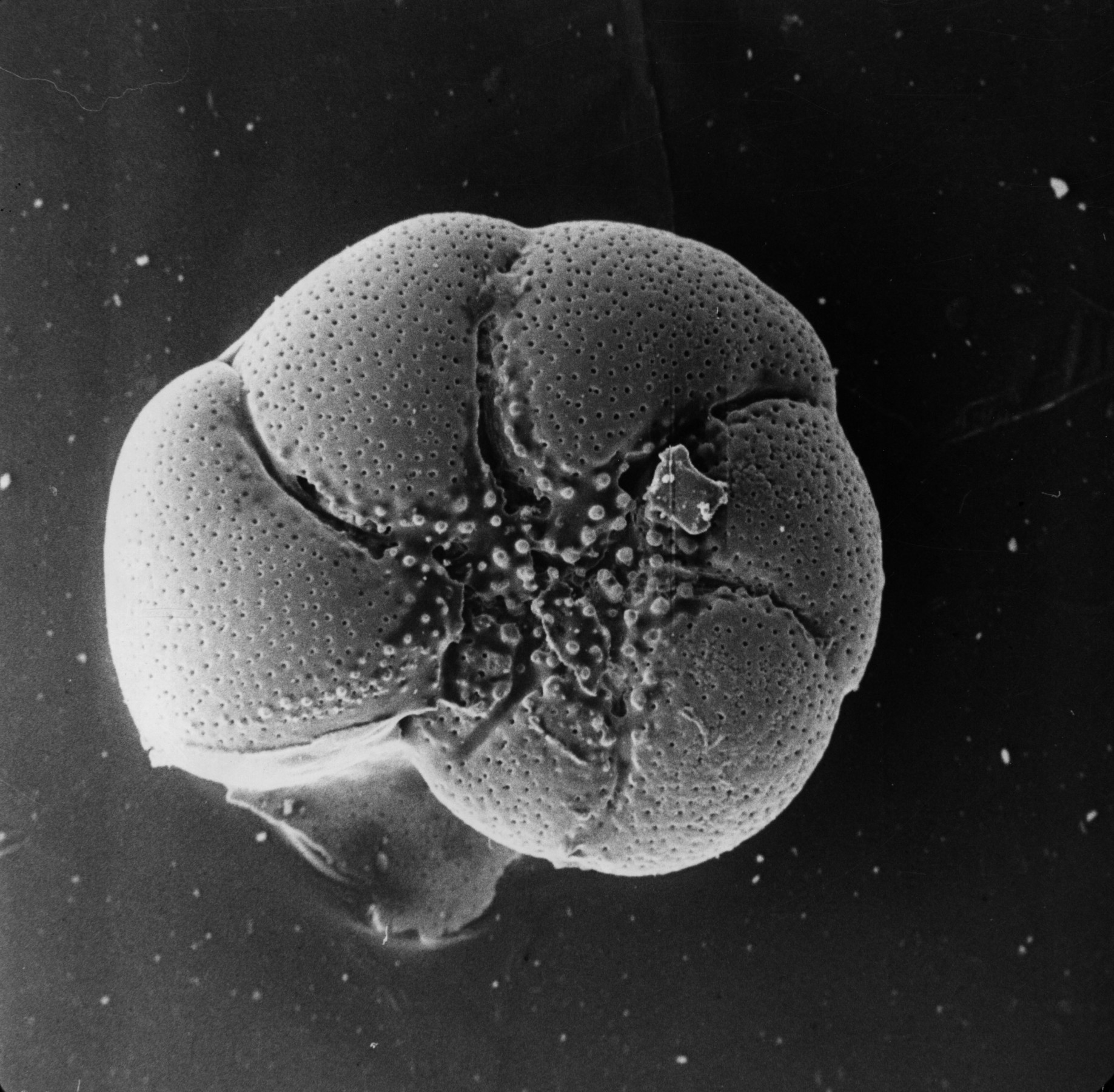
An electron scanning micrograph of a foraminiferan species (Elphidium) (Source: Hannes Grobe/Wikimedia, CC BY)
An important part of the micropaleontological collections at the Museum für Naturkunde Berlin,1 foraminifera (or, informally, forams) are marine single-celled organisms. Their soft, amoeba-like body is enveloped in an external shell, called test, composed of calcium carbonate. Despite their diminutive size, or thanks to it, they are important players in the ecology of our planet. As heterotrophs, they primarily feed on other microscopic organisms drifting around them; but most foraminifera have photosynthetic endosymbionts – microscopic organisms embedded within their bodies who transform light into energy that the foram can then use. A few species are also known to be kleptoplastic, which means they can steal chloroplasts from ingested algae. Once the foram cell dies, their hard siliceous tests sink to the bottom, covering the ocean floor with a carbonaceous ooze. Thanks to their structure and composition, these remains can survive and become fossilised, as they get trapped in sediments and geological strata. Because of this process, the microfossils of foraminiferal tests can be found in various types of geological formations and can provide an important and often readily accessible fossil record. In fact, since their discovery, forams have been used in the study of  micropaleontological formations. Among all microfossils, foraminifera have been the most studied, also thanks to their prevalence in common materials like limestone; indeed, already Herodotus had observed them embedded in the stones that were used to build the pyramids in Giza.
micropaleontological formations. Among all microfossils, foraminifera have been the most studied, also thanks to their prevalence in common materials like limestone; indeed, already Herodotus had observed them embedded in the stones that were used to build the pyramids in Giza.
In the beginning of the 19th century, early naturalists like Alcide d’Orbigny, believed foraminifera to be microscopic cephalopods (molluscs like squids, octopi, and nautili). Only in 1835 another French naturalist, Felix Dujardin recognised their protozoan nature, but the  chaotic origins of micropaleontology remained murky for the rest of the century, as they seemed to encounter
chaotic origins of micropaleontology remained murky for the rest of the century, as they seemed to encounter  micropaleontological evolutionary dead ends. This also reflected on the study of foraminifera.
micropaleontological evolutionary dead ends. This also reflected on the study of foraminifera.
This indifference was finally overcome in the 1920s, as a group of scientists inaugurated the extremely successful field of  industrial micropaleontology. Thanks to their small size, resistance, and abundance, as well as their variety, foraminiferal tests have since then been used extensively to study geology and oceanography: their impressive fossil record (reaching back to the Cambrian, 500 million years ago) makes them important diagnostic fossils. As such they are used in
industrial micropaleontology. Thanks to their small size, resistance, and abundance, as well as their variety, foraminiferal tests have since then been used extensively to study geology and oceanography: their impressive fossil record (reaching back to the Cambrian, 500 million years ago) makes them important diagnostic fossils. As such they are used in  biostratigraphy, to date geological samples. Some species, in particular, can provide important environmental data, and are used in planetary sciences as proxies and markers of ancient climates. Furthermore, thanks to their small size, they can be extracted and analysed from the cutting of a
biostratigraphy, to date geological samples. Some species, in particular, can provide important environmental data, and are used in planetary sciences as proxies and markers of ancient climates. Furthermore, thanks to their small size, they can be extracted and analysed from the cutting of a  geological drill, making them easy to use, cheap, and efficient. For these reasons they are not only central in paleoclimatology and paleo-oceanography, but also in applied geological sciences, being used, for example, in prospecting for
geological drill, making them easy to use, cheap, and efficient. For these reasons they are not only central in paleoclimatology and paleo-oceanography, but also in applied geological sciences, being used, for example, in prospecting for  fossil fuels and the extractive industry writ large.
fossil fuels and the extractive industry writ large.
This video from the American Museum of Natural History introduces foraminifera micropaleontology. (Source: American Museum of Natural History/YouTube)
- To learn more, visit the micropaleontological collections at the Museum für Naturkunde: https://www.museumfuernaturkunde.berlin/en/science/micropaleontology-collections (03.01.2022).↩